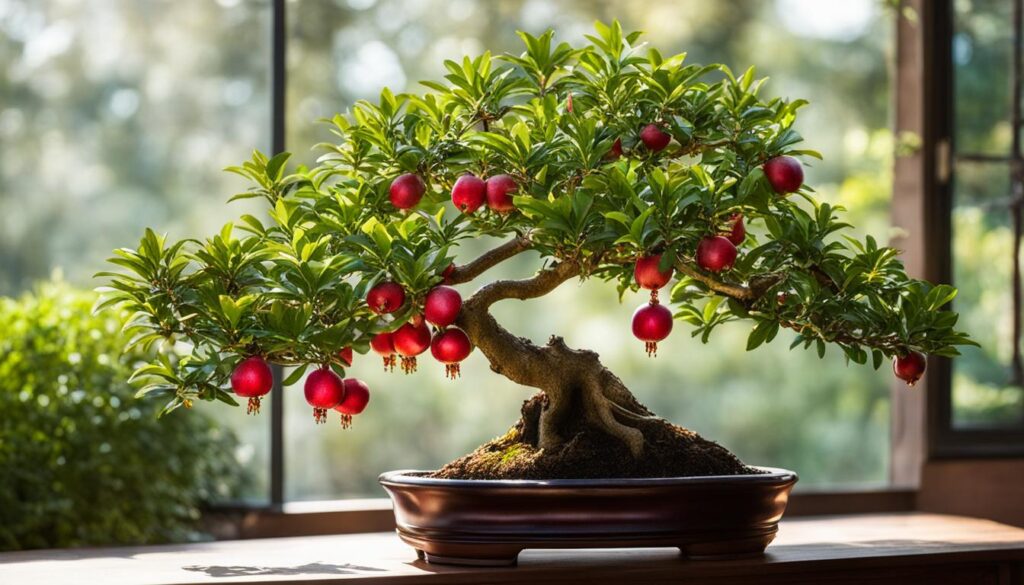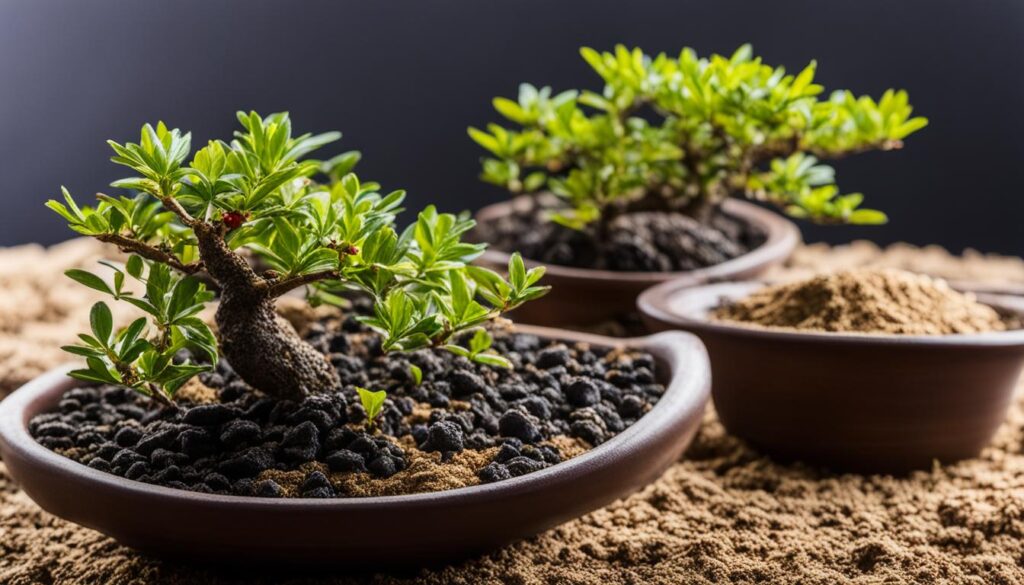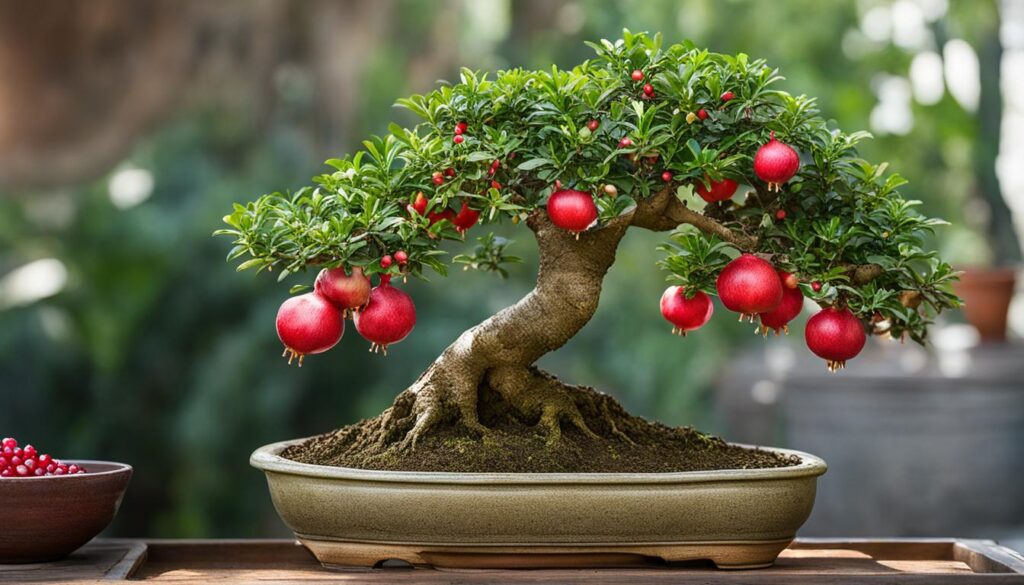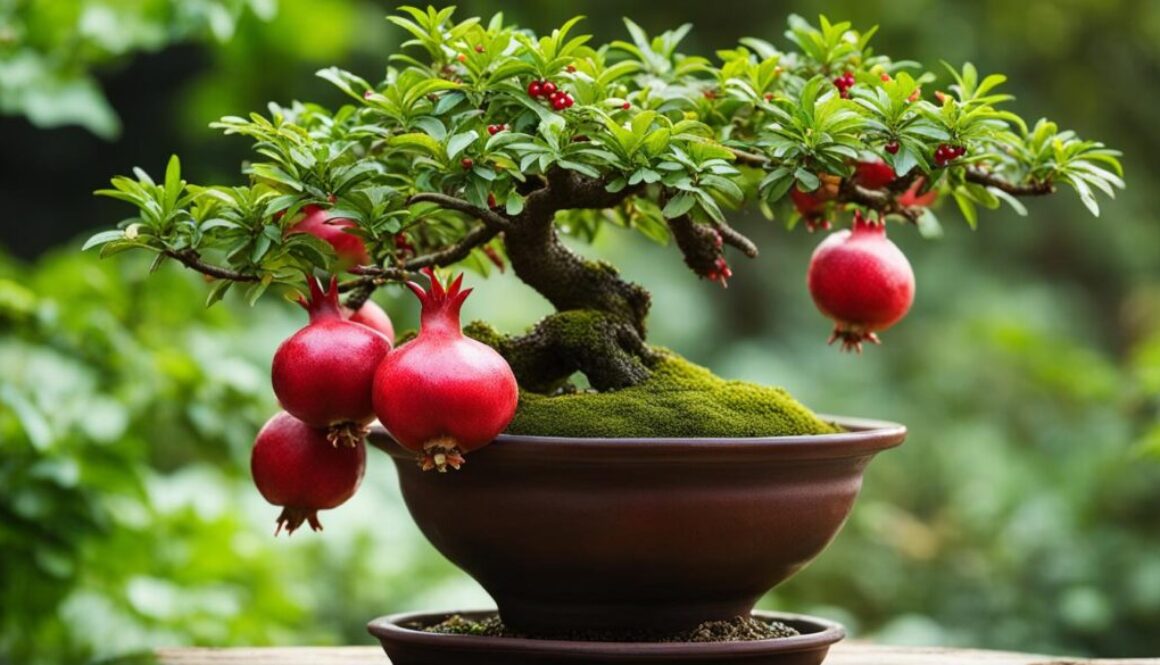Pomegranate Bonsai Growing and Care Guide
If you’ve always been fascinated by the unique beauty and historical significance of bonsai, pomegranate bonsai is an excellent choice to explore. Not only are these trees visually stunning with their vibrant flowers, intriguing fruit, a really fast growth but they also offer a delightful challenge for bonsai enthusiasts.
We will start by exploring the historical significance and aesthetic appeal. Discover the cultural and symbolic meanings behind these captivating trees and learn about the unique dwarf varieties with twisted trunks.
You will then dive into the essential tips for beginners, from selecting the right varietal for your climate to potting and basic shaping techniques. We will guide you in positioning your bonsai for optimal growth and teach you about the importance of the soil mix and watering techniques. Additionally, we will explore the key aspects of fertilization and share pruning and wiring techniques to help you shape and maintain your pomegranate bonsai’s form. We will also discuss seasonal care and provide insights into dealing with common pests.
Unveiling the Unique World of Pomegranate Bonsai

Pomegranate bonsai trees have a rich historical and mythical lore, making them unique and captivating additions to any bonsai collection. These miniature versions of the pomegranate tree are not only aesthetically appealing but also carry cultural and symbolic meanings.
The Historical Significance and Aesthetic Appeal of Pomegranate Bonsai
The pomegranate tree holds cultural significance in various civilizations throughout history. It is often associated with fertility, abundance, and prosperity. In ancient Greek mythology, the pomegranate symbolized life, regeneration, and the underworld. Its vibrant red flowers and fruit evoke a sense of beauty and vitality, making it a popular choice for bonsai enthusiasts seeking a visually striking tree.
Understanding the Dwarf Variety ‘Nana’ and ‘Nejikan’ with Twisted Trunks
Among the many pomegranate bonsai varieties, two popular dwarf options stand out: ‘Nana’ and ‘Nejikan’. These varieties are known for their twisted trunks, which add an intriguing element to the bonsai design. With their unique growth patterns and visually captivating forms, these varieties are highly sought after by bonsai artists and collectors alike.
Bonsai – A Blend of Art and Horticulture
Bonsai is more than just a horticultural practice; it is a harmonious blend of art and cultivation. Shaping and styling a pomegranate bonsai requires creative expression and an understanding of horticultural principles. It is a form of art that involves sculpting living trees into miniature masterpieces. By carefully nurturing these trees and channeling artistic vision, bonsai enthusiasts create captivating displays that reflect their unique style and creativity.
Essential Starting Tips for Pomegranate Bonsai Newbies
If you are new to growing pomegranate bonsai, there are a few essential tips to help you get started on the right track. In this section, we will guide you through the process of selecting the right varietal for your climate, the initial steps of potting and basic shaping, and the importance of positioning your bonsai for optimal growth and health.
Selecting the Right Varietal for Your Climate
When choosing a pomegranate bonsai varietal, it is important to consider your climate. Different varieties have specific temperature and humidity requirements, so selecting the right one will greatly contribute to the success of your bonsai. Research the climate conditions in your area and choose a varietal that can thrive in those conditions. Some popular pomegranate bonsai varieties that are known for their adaptability include ‘Wonderful’, ‘Nana’, and ‘Nejikan’.
The Initial Steps: Potting and Basic Shaping
Once you have selected the right varietal, it’s time to pot and shape your pomegranate bonsai. Start by choosing a suitable bonsai container that is slightly larger than the root ball of your tree. Use a well-draining bonsai soil mix and ensure that the pot has drainage holes to prevent waterlogging. Carefully position the tree in the pot, making sure the roots are spread evenly and not cramped.
After potting, basic shaping is crucial to establish the bonsai’s form. Remove any dead, damaged, or crossing branches with clean and sharp bonsai pruning shears. Shape the tree by creating a compact and balanced structure, keeping in mind the desired design and style. Take your time and pay attention to detail during this important shaping process.
Positioning Your Bonsai for Optimal Growth and Health
Proper positioning of your pomegranate bonsai is essential for its overall growth and health. Ensure that your bonsai receives adequate sunlight for at least 4-6 hours a day, as pomegranate trees need ample light to thrive. Place your bonsai near a south or west-facing window, patio, or balcony to provide the necessary sunlight. However, be cautious of excessive heat or direct sunlight during the hottest parts of the day, as it can scorch the leaves.
In addition to sunlight, pay attention to the temperature and humidity levels. Pomegranate bonsai trees prefer a mild climate with temperatures ranging from 50°F to 86°F (10°C to 30°C). Avoid exposing your bonsai to extreme temperatures or drafts that can stress the tree.
Create a suitable microclimate by grouping your bonsai with other plants or using humidity trays filled with water to maintain ideal humidity levels. Regularly mist the foliage to mimic the humid conditions that pomegranate trees thrive in.
By following these essential starting tips, you will set a solid foundation for your pomegranate bonsai’s growth and ensure its long-term health and vitality.
Mastering the Soil Mix and Watering Techniques for Pomegranate Bonsai

The soil mix and watering techniques are essential factors that contribute to the overall health and well-being of your pomegranate bonsai. Creating the perfect soil mix and adopting proper watering practices will ensure that your bonsai thrives and flourishes. Let’s explore these two key aspects in detail.
1. Creating the perfect soil mix:
When it comes to pomegranate bonsai, the right soil mix is crucial for providing adequate drainage, nutrient availability, and a suitable environment for root growth. A well-draining soil mix will prevent waterlogged roots and the onset of root rot. Ideally, a pomegranate bonsai requires a mixture of organic matter, inorganic particles, and moisture-retaining components. Here’s a simple recipe to create the perfect soil mix:
- Start with a base of well-draining soil, such as bonsai soil or a mix of coarse sand and perlite.
- Add organic matter such as peat moss or compost to enhance nutrient retention.
- Include a small amount of crushed lava rock or pumice to improve aeration and prevent compaction.
By blending these components in the right proportions, you will create a soil mix that promotes healthy root development and allows the pomegranate bonsai to thrive.
2. Mastering watering techniques:
Watering your pomegranate bonsai correctly is crucial for its overall health. Both under and overwatering can have adverse effects on the tree’s growth and vitality. Here are some guidelines to help you master the art of watering:
- Observe your bonsai closely to determine its watering needs. Pomegranate bonsai prefer slightly moist soil, so aim to keep the soil evenly moist without letting it become overly saturated.
- Water your bonsai thoroughly until you see water draining from the bottom of the pot. This ensures that the entire root system is adequately hydrated.
- Check the moisture level of the soil by inserting your finger into the soil up to the second knuckle. If the soil feels slightly moist, it indicates that it’s time to water again. If it’s still wet, hold off on watering for a few more days.
Remember, the watering frequency may vary depending on factors such as climate, humidity, and the specific needs of your pomegranate bonsai. Regularly monitoring and adjusting your watering routine will help you provide optimal care for your bonsai.
Nurturing Your Pomegranate Bonsai with Proper Fertilization

Fertilization plays a crucial role in the growth and vitality of your pomegranate bonsai. By providing the necessary nutrients, you can ensure that your bonsai tree thrives and flourishes. In this section, we will discuss the proper techniques and frequency for fertilizing your pomegranate bonsai, as well as the specific types of fertilizers that are best suited for these trees.
When it comes to fertilizing your pomegranate bonsai, it is important to strike a balance. Too much fertilizer can lead to excessive foliage growth but may hinder flowering and fruiting. On the other hand, insufficient fertilization can result in stunted growth and a lack of vigor.
To achieve optimal fertilization, it is recommended to use a balanced, slow-release fertilizer specifically formulated for bonsai trees. Look for a fertilizer with a balanced NPK ratio, such as a 10-10-10 or 14-14-14 blend. This balanced ratio ensures that your pomegranate bonsai receives a sufficient supply of nitrogen, phosphorus, and potassium, essential nutrients for its overall health and development.
Please note that the fertilization requirements of your pomegranate bonsai may vary depending on its age and stage of development. Younger bonsai trees may require less frequent fertilization, while more mature trees may benefit from a slightly higher frequency.
When applying fertilizer, be sure to follow the manufacturer’s instructions regarding dosage and frequency. Typically, fertilization is performed every four to six weeks during the growing season, which is typically spring through early autumn. During the dormant season, it is best to refrain from fertilizing to allow the tree to rest and prepare for the upcoming growth cycle.
Remember, consistency is key when it comes to fertilizing your pomegranate bonsai. Establish a regular fertilization schedule and monitor the tree’s response to ensure it is receiving the proper nutrients for healthy growth. With the right fertilization approach, you can nurture your pomegranate bonsai into a stunning and thriving centerpiece of your bonsai collection.
Pomegranate Bonsai Pruning and Wiring Techniques
Pruning and wiring are essential techniques for shaping and maintaining the desired form of your pomegranate bonsai. By strategically pruning and utilizing wiring, you can guide the growth of your bonsai and enhance its aesthetic appeal. In this section, we will explore the art of pruning, the use of wiring, and how to manage flowering and fruiting for an attractive display.
Shape of Your Bonsai through Strategic Pruning
Pruning is a crucial aspect of bonsai care that involves selectively removing branches, shoots, and foliage to achieve the desired shape and style. With pomegranate bonsai, pruning is particularly important for maintaining a compact form and enhancing the tree’s natural characteristics.
When pruning your pomegranate bonsai, it’s essential to keep the following in mind:
- Timing: Prune your bonsai during the dormant period in late winter or early spring, before new growth emerges.
- Tools: Use sharp, clean pruning shears to make precise cuts without causing damage.
- Techniques: Employ various pruning techniques, including branch selection, thinning, and shortening, to shape your bonsai effectively.
- Aesthetic considerations: Consider the overall design and flow of your bonsai when making pruning decisions, focusing on creating balance and harmony.
Utilizing Wiring to Achieve Desired Growth Patterns
Wiring is another valuable technique that allows you to shape the branches and trunk of your pomegranate bonsai. By gently bending and guiding the branches, you can create movement and structure that contribute to the tree’s overall aesthetic appeal.
Here are some key points to keep in mind when wiring your pomegranate bonsai:
- Timing: Wire your bonsai during the active growth period in spring or early summer when the branches are flexible and pliable.
- Selection: Choose appropriate gauge wire that is strong enough to hold the branches in position without causing damage.
- Techniques: Apply the wire in a spiral motion, starting from the base and working your way up, ensuring it is wrapped snugly around the branch.
- Monitoring: Regularly check the wiring to prevent it from cutting into the branches as they grow and thicken. Adjust or remove the wire as needed.
Managing Flowering and Fruiting for an Attractive Display
In addition to shaping your pomegranate bonsai, managing flowering and fruiting is essential for creating a stunning visual display. By following specific care practices, you can encourage your bonsai to produce beautiful flowers and edible fruits.
Consider the following tips for managing flowering and fruiting in your pomegranate bonsai:
- Fertilization: Use a balanced fertilizer with a higher ratio of phosphorus to promote flower and fruit development.
- Temperature and Light: Provide your bonsai with the optimal temperature and light conditions for fruit set, which typically require warm temperatures and full sunlight.
- Pollination: If growing your bonsai indoors, manually pollinate the flowers using a small brush or cotton swab to transfer pollen from one flower to another.
- Thinning: As the fruits develop, thin them out to ensure proper growth and spacing, allowing for better air circulation and reducing the risk of disease.
Find more fruiting bonsai trees
Seasonal Care and Common Pests Affecting Pomegranate Bonsai
To ensure the long-term health and vitality of your pomegranate bonsai, it is crucial to understand its seasonal care requirements and be aware of common pests that can affect its well-being. By following these guidelines, you can keep your bonsai thriving throughout the year.
During each season, specific care tasks should be performed to promote optimal growth. In spring, focus on pruning any dead or damaged branches, which will stimulate new growth. Additionally, repotting your pomegranate bonsai every two to three years will provide fresh soil and nutrients. Summer care involves protecting your bonsai from extreme heat and sunlight by providing shade during the hottest part of the day. In autumn, gradually reduce watering and fertilizer to prepare the tree for dormancy. And in winter, protect your bonsai from freezing temperatures by placing it in a sheltered area or using insulation materials.
Unfortunately, common pests can pose a threat to the health of your pomegranate bonsai. Aphids, mealybugs, and scale insects are known to infest bonsai trees, causing damage to the foliage and overall health. To prevent infestations, regularly inspect your bonsai for any signs of pests, including sticky residue, yellowing leaves, or distorted growth. If you spot any pests, there are several treatment options available, including insecticidal soaps and oils. Applying these solutions according to the instructions will help eliminate pests and protect your bonsai.
By following the recommended seasonal care tasks and staying vigilant against common pests, you can ensure that your pomegranate bonsai thrives. With proper care and attention, your bonsai will continue to delight you with its beauty and provide a stunning centerpiece for your home or garden.

Karen Phillips, Bonsai expert and blogger. Read more about me here

